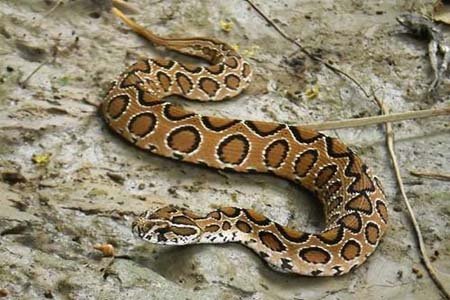

The Russell’s viper (Daboia russelii) is a stocky, venomous snake native to the vast swaths of open land across southern and southeastern Asia. Feared for its potent venom and responsible for a significant number of snakebite incidents within its range, this viper also holds a certain ecological importance. Let’s delve deeper into the world of the Russell’s viper, exploring its physical characteristics, behavior, habitat, and the role it plays in the Asian ecosystem.
A Name Steeped in History:
The Russell’s viper gets its name from Patrick Russell, a Scottish surgeon who documented numerous Indian snakes during the British Raj in the 18th century. Russell’s extensive research on this particular viper led to its scientific classification in 1797. This viper is also included among the “big four” snakes of India, a group of snakes responsible for a high number of snakebite fatalities on the subcontinent.
A Distinctive Looker:
The Russell’s viper is a medium-sized snake, typically reaching lengths of around 1.5 meters (5 feet). Its body is broad and muscular, well-adapted for striking and overpowering prey. The most striking feature of this viper is its coloration. Its body is adorned with a series of three rows of reddish-brown ovals outlined in black and white, a characteristic pattern that aids in camouflage amidst leaf litter and forest floors.
Masters of Night and Opportunistic Feeders:
Russell’s vipers are primarily nocturnal creatures, emerging under the cloak of darkness to hunt. Their diet consists mainly of rodents, which are abundant in the farmlands and open fields where these vipers frequently reside. They are ambush predators, lying in wait for unsuspecting prey and striking with lightning speed when an opportunity arises. Their viper fangs inject a potent venom that quickly subdues their victims. Russell’s vipers are also known to be opportunistic feeders, consuming lizards, amphibians, and even small birds when the occasion presents itself.
Adaptable Habitats:
The Russell’s viper demonstrates remarkable adaptability when it comes to habitat selection. They thrive in various environments, including open forests, grasslands, agricultural lands, and even human settlements. Their ability to survive in close proximity to humans is a significant factor contributing to the high number of snakebite incidents in South Asia. They are also adept swimmers and can sometimes be found near water bodies.
A Complex Venom with Devastating Effects:
The venom of the Russell’s viper is a complex mix of toxins that can cause a range of devastating effects on a bite victim. Common symptoms include localized pain, swelling, and tissue necrosis. The venom can also disrupt blood clotting mechanisms and cause internal bleeding. In severe cases, it can lead to kidney failure and even death. Fortunately, effective antivenoms are available, and timely medical intervention can significantly improve the chances of survival.
Breeding and Life Cycle:
Russell’s vipers are viviparous, meaning they give birth to live young. Females typically produce litters of up to 25 neonates, who are born fully independent and ready to hunt for themselves. These young vipers are immediately venomous and just as dangerous as their adult counterparts.
The Role of the Russell’s Viper in the Ecosystem:
Despite their fearsome reputation, Russell’s vipers play a crucial role in maintaining the ecological balance within their habitats. By preying on rodents and other small mammals, they help to control their populations and prevent them from becoming overabundant. This, in turn, protects agricultural crops and maintains the health of the ecosystem.
Conservation Concerns:
While the Russell’s viper is a widespread and common species, habitat loss due to human encroachment and agricultural development is a growing concern. Additionally, accidental killings due to fear and misunderstanding pose a threat to their populations. Education and awareness campaigns play a vital role in promoting peaceful coexistence between humans and these fascinating, yet potentially dangerous, creatures.
Living Alongside the Russell’s Viper:
If you live in an area where Russell’s vipers are present, it’s important to be aware of their presence and take precautions to avoid encounters. Wearing proper shoes and protective clothing when venturing into tall grass or fields can minimize the risk of stepping on a camouflaged viper. If you encounter a viper, it’s best to maintain a safe distance and slowly back away. Do not attempt to handle or provoke the snake. In case of a bite, seek immediate medical attention.
By understanding the Russell’s viper’s behavior, habitat, and ecological importance, we can learn to appreciate this fascinating predator while taking necessary steps to ensure our safety and the snake’s continued survival.